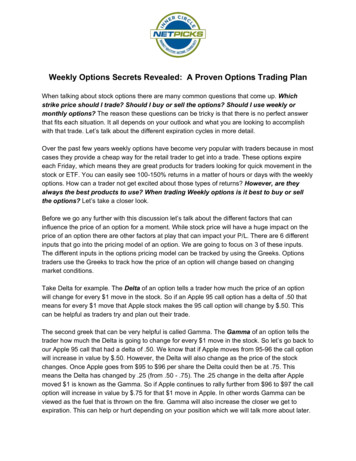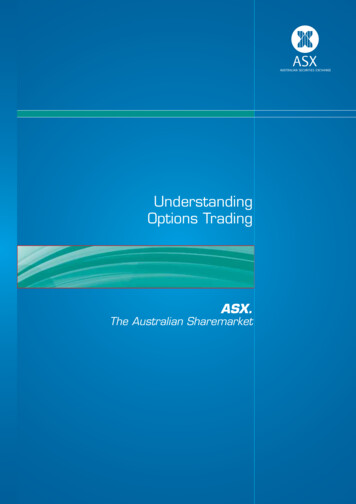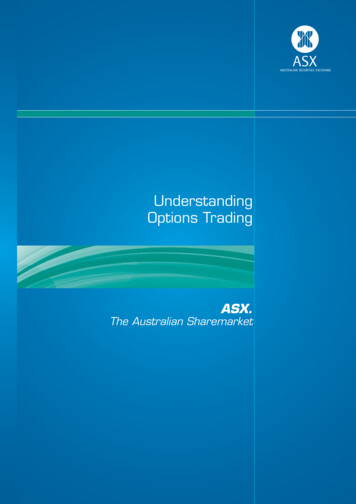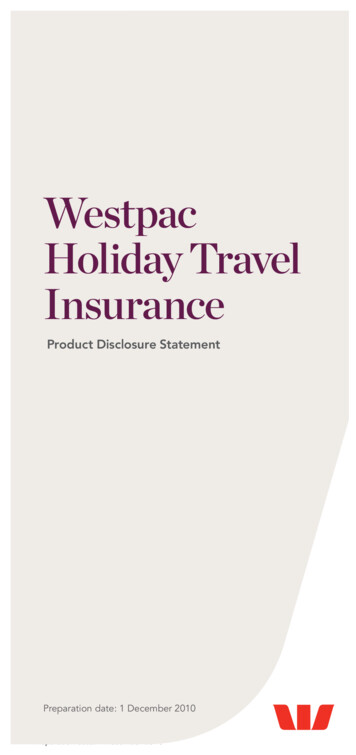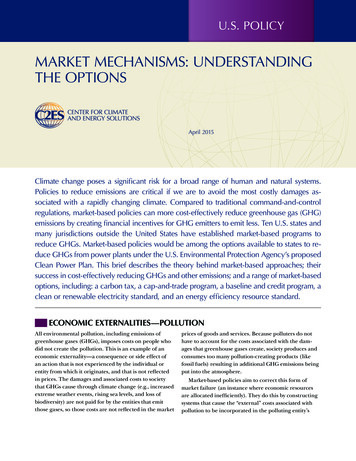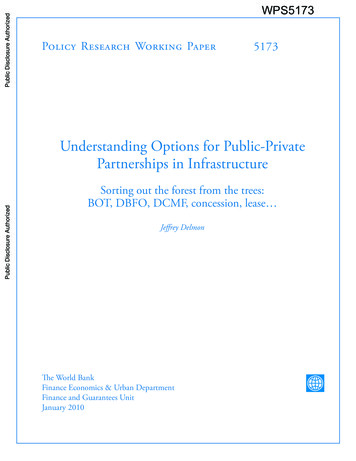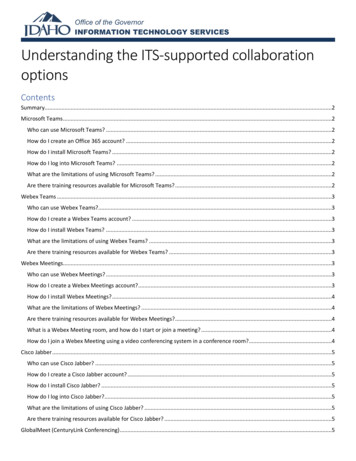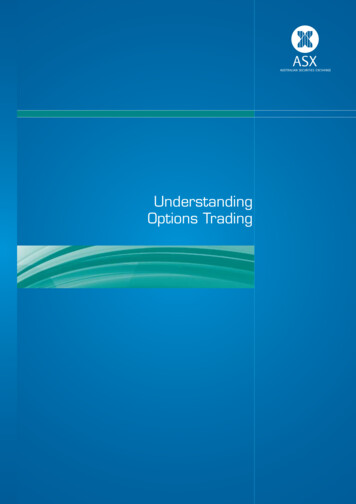
Transcription
UnderstandingOptions Trading
Disclaimer of LiabilityInformation provided is for educational purposes and does not constitute financial product advice. Youshould obtain independent advice from an Australian financial services licensee before making any financialdecisions. Although ASX Limited ABN 98 008 624 691 and its related bodies corporate (‘ASX’) hasmade every effort to ensure the accuracy of the information as at the date of publication, ASX does notgive any warranty or representation as to the accuracy, reliability or completeness of the information.To the extent permitted by law, ASX and its employees, officers and contractors shall not be liable forany loss or damage arising in any way (including by way of negligence) from or in connection with anyinformation provided or omitted or from any one acting or refraining to act in reliance on this information.No part of this Booklet may be copied, reproduced, published, stored in a retrieval system or transmittedin any form or by any means in whole or in part without the prior written permission of the ASX Group.For these product/s the market is operated by ASX Limited ACN 008 624 691.All Ordinaries , All Ords , ASX , ASX100 *, ASX200 *, CHESS , and ITS are trade marks of ASXOperations Pty Limited, a member of the ASX Group. For those trade marks indicated with an asterisk,ASXO has entered into an arrangement with Standard & Poor’s (S&P ). Those trade marks must beprefaced by the mark S&P when used to describe indices. S&P is a trade mark of Standard & Poor’s,a division of The McGraw-Hill Companies, Inc.Edition 10 printed July 2007. Copyright 2007 ASX Limited ABN 98 008 624 691. All rights reserved 2007.Exchange Centre, 20 Bridge Street, Sydney NSW 2000Telephone: 131 279www.asx.com.au
ContentsBefore you begin2Taxation16What is an option?3Tradeability17Call options3Put options4Advantages of option trading5Risk management5How can optionswork for you?18Time to decide5Speculation5Trading index options20Leverage5Diversification5How are index options different?20Income generation5Settlement method20Option features6Examples of how trading indexThe 5 components of an option contract6options can work for you1. Underlying securities/approved indices62. Contract size63. Expiry day64. Exercise (or strike) price5. Premiumtrading index options21Differences between equity237Pay-off diagrams247Call option taker24Call option writer24Put option taker25Put option writer25Summary26Risks of options trading27You and your broker28Your relationship with your broker28The paperwork: Client Agreement forms28Instructing a broker to trade options29Role of market makers30Australian Clearing House31Glossary of terms33Option contract specifications35Further information368Option pricing fundamentals9Intrinsic value9Call options9Put options910Parties to an option contract11The option taker11The option writer13Tracking positions and costs14How to track options positions14Costs14Margins21options and index optionsAdjustments to optioncontractsTime valueSome key advantages of151
Before you beginThe ASX exchange traded options market hasbeen operating since 1976. Since the marketstarted, volumes have increased significantly.There are now over 100 different companiesand several indices to choose from. A list ofcompanies and indices over which ExchangeTraded Options (options) are traded can befound on the ASX website, www.asx.com.au/options (under Option Stocks in the “TradingInformation” section).This booklet explains the concepts of options,how they work and what they can be usedfor. It should be noted that this booklet dealsexclusively with Exchange Traded Options overlisted shares and indices, and not companyissued options. Information on other ASXproducts is available by calling 1300 300 279or visiting www.asx.com.au. To assist in yourunderstanding there is a glossary of termson page 33.2Option sellers are referred to as ‘writers’ becausethey underwrite (or willingly accept) the obligationto deliver or accept the shares covered by anoption. Similarly, buyers are referred to as the‘takers’ of an option as they take up the right tobuy or sell a parcel of shares.Every option contract has both a taker (buyer)and a writer (seller). Options can provideprotection for a share portfolio, additionalincome or trading profits. Both the purchaseand sale of options, however, involve risk.Transactions should only be entered into byinvestors who understand the nature andextent of their rights, obligations and risks.
What is an option?An option is a contract between two partiesgiving the taker (buyer) the right, but notthe obligation, to buy or sell a securityat a predetermined price on or before apredetermined date. To acquire this right thetaker pays a premium to the writer (seller) ofthe contract.There are two types of options available:call options and put options.Call optionsCall options give the taker the right, but notthe obligation, to buy the underlying sharesat a predetermined price, on or before apredetermined date.For illustrative purposes, the term shares isused throughout this booklet when referringto the underlying securities. When consideringoptions over an index, the same conceptsgenerally apply. From time to time options maybe available over other types of securities suchas instalment receipts or preference shares.Call option exampleThe standard number of shares covered by oneoption contract on ASX is 1,000. However, thismay change due to adjustment events such asa new issue or a reorganisation of capital in theunderlying share.All of the examples in this booklet assume1,000 shares per contract and ignore brokerageand ASX fees. You will most definitely need toconsider these when evaluating an optiontransaction. For options over an index, thecontract value is based on a dollar valuepoint. Details can be checked in the contractspecifications.TAKER(BUYER)BROKERAssume Santos Ltd (STO) shares have a lastsale price of 14.00. An available 3 monthoption would be a STO 3 month 14.00 call.A taker of this contract has the right, but notthe obligation, to buy 1,000 STO shares for 14.00 per share at any time until the expiry*.For this right, the taker pays a premium (orpurchase price) to the writer of the option.In order to take up this right to buy the STOshares at the specified price, the taker mustexercise the option on or before expiry.On the other hand, the writer of this calloption is obliged to deliver 1,000 STO sharesat 14.00 per share if the taker exercisesthe option. For accepting this obligation thewriter receives and keeps the option premiumwhether the option is exercised or not.ASXBROKERWRITER(SELLER)It is important to note that the taker is not obligatedto exercise the option.* The expiry day for stock options is usually the Thursday before the last Friday in the expiry month unless ACH determinesanother day. This may change for various reasons (eg. for public holidays), so please check with your broker. For indexoptions, refer to the contract specifications.3
Put optionsPut options give the taker the right but notthe obligation to sell the underlying sharesat a predetermined price on or before apredetermined date. The taker of a put isonly required to deliver the underlying sharesif they exercise the option.Put option exampleAn available option would be a STO 3 month 14.00 put. This gives the taker the right, butnot the obligation, to sell 1,000 STO sharesfor 14.00 per share at any time until expiry.For this right, the taker pays a premium (orpurchase price) to the writer of the put option.In order to take up this right to sell the STOshares at a specified price the taker mustexercise the option on or before expiry. Thewriter of the put option is obliged to buy theSTO shares for 14.00 per share if the optionis exercised. As with call options, the writerof a put option receives and keeps the optionpremium whether the option is exercised or not.Once again it isimportant to note thatthe taker is not obligatedto exercise the option.If the call or put option is exercised, the sharesare traded at the specified price. This priceis called the exercise or strike price. The lastdate when an option can be exercised is calledexpiry day.There are two different exercise styles:American style, which means the option canbe exercised at any time prior to the expiry; andEuropean style, which means the option canonly be exercised on the expiry day. Most stockoptions traded on ASX are American style.RIGHTS AND OBLIGATIONS4CALL OPTIONTAKER(BUYER)Taker receives the right to buy shares at the exerciseprice in return for paying the premium to the writer.Writer receives and keeps premium butnow has the obligation to deliver sharesif the taker exercises.WRITER *(SELLER)PUT OPTION*TAKER(BUYER)Taker receives the right to sell shares at the exerciseprice in return for paying the premium to the writer.Writer receives and keeps premium butnow has the obligation to buy the underlying sharesif the taker exercises.* The taker of a put and writer of a call option do not have to own the underlying shares.WRITER(SELLER)
Advantages of option tradingRisk managementPut options allow you to hedge against apossible fall in the value of shares you hold.This can be considered similar to taking outinsurance against a fall in the share price.Time to decideBy taking a call option, the purchase pricefor the shares is locked in. This gives the calloption holder until the expiry day to decidewhether or not to exercise the option and buythe shares. Likewise the taker of a put optionhas time to decide whether or not to sellthe shares.SpeculationThe ease of trading in and out of an optionposition makes it possible to trade optionswith no intention of ever exercising them.If you expect the market to rise, you maydecide to buy call options. If you expect a fall,you may decide to buy put options.Either way you can sell the option prior toexpiry to take a profit or limit a loss.LeverageLeverage provides the potential to make ahigher return from a smaller initial outlay thaninvesting directly. However, leverage usuallyinvolves more risks than a direct investmentin the underlying shares. Trading in optionscan allow you to benefit from a change in theprice of the share without having to pay the fullprice of the share. The following example helpsillustrate how leverage can work for you.The table below compares the purchaseof 1 call option and 1,000 shares. Thehigher percentage return from the optiondemonstrates how leverage can work.OptionStockBought on October 15 380 4,000Sold on December 15 670 4,500Profit 290 50076.3%12.5%Return on investment(not annualised)DiversificationOptions can allow you to build a diversifiedportfolio for a lower initial outlay thanpurchasing shares directly.Income generationYou can earn extra income over and abovedividends by writing call options against yourshares, including shares bought on margin.By writing an option you receive the optionpremium up front. While you get to keep theoption premium, there is a possibility that youcould be exercised against and have to deliveryour shares at the exercise price.5
Option featuresThe ease of trading in and out of optionson ASX‘s Options Market is assisted by thestandardisation of the following option contractcomponents:1. Underlying securities,2. Contract size,3. Expiry day, and4. Exercise prices.There is a fifth component, the optionpremium, which is not standardised but ratherdetermined by market forces. ASX operatesthe Options Market, while Australian ClearingHouse Pty Ltd (ACH) operates the clearingfacility for ASX‘s Options Market. AmongASX‘s responsibilities is the setting of thestandardised option components.61 option contract usuallyrepresents 1,000underlying shares.The 5 components of an optioncontract1. Underlying securities/approved indicesOptions traded on ASX‘s Options Marketare only available for certain securities andapproved indices. These securities are referredto as underlying securities or underlyingshares. They must be listed on ASX andare selected by ACH according to specificguidelines. The issuers of underlying securitiesdo not participate in the selection of securitiesagainst which options may be listed.Calls and puts over the same underlyingsecurity are termed classes of options.For example, all call and put options listedover Lend Lease Corporation (LLC) shares,regardless of exercise price and expiry day,form one class of option. A list of all theclasses of options trading on ASX‘s OptionsMarket can be found on the ASX websitewww.asx.com.au/options (in the “TradingInformation” section).2. Contract sizeOn ASX‘s Options Market an option contractsize is standardised at 1,000 underlyingshares. That means, 1 option contractrepresents 1,000 underlying shares. Asmentioned earlier, this may change if thereis an adjustment such as a new issue or areorganisation of capital in the underlyingshare. In the case of index options, contractvalue is fixed at a certain number of dollarsper index point (for example, 10 per indexpoint). The size of the contract is equal to theindex level x the dollar value per index point(for example, for an index at 6,000 points, 1contract would be 6,000 x 10 60,000).3. Expiry dayOptions have a limited life span and expire onstandard expiry days set by ACH. The expiryday is the day on which all unexercised optionsin a particular series expire and is the last dayof trading for that particular series. For sharesthis is usually the Thursday before the lastFriday in the month. For index options, expiryis usually the third Thursday of the contractmonth. However, ACH has the right to changethis date should the need arise. In general, alloptions for a particular class follow one of thethree quarterly cycles listed below: January/April/July/October; February/May/August/November; or March/June/September/December.Options are usually listed for the next threemonths in the quarterly expiry cycle.For example, assume it i
options (under Option Stocks in the “Trading Information” section). This booklet explains the concepts of options, how they work and what they can be used for. It should be noted that this booklet deals exclusively with Exchange Traded Options over listed shares and indices, and not company issued options. Information on other ASX
